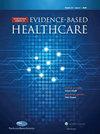Risk of bias analysis in diabetic retinopathy randomized clinical trials evaluated by RoB-1 tool from Cochrane systematic reviews
Q3 Medicine
International Journal of Evidence-Based Healthcare
Pub Date : 2022-04-20
DOI:10.17267/2675-021xevidence.2022.e3791
引用次数: 0
Abstract
The objective of clinical trials is to answer about intervention in the real-world, for which they must be properly designed and executed by presenting the results reliably with the findings and in a clear way. OBJECTIVES: To identify the risk of bias in clinical trials about interventions for diabetic retinopathy and/or diabetic macular edema from Cochrane systematic reviews. METHODS: A sensitive search strategy was designed to search Cochrane systematic reviews of interventions in diabetic retinopathy and diabetic macular edema. The assessment of the risk of bias was captured as presented by the author. FINDINGS: We found eight SR and one meta-analysis network totaling 116 randomized clinical trials. Our sample revealed that among the domains randomization, allocation secret, masking of participants and personnel, incomplete outcomes, selective outcomes and others, the risk of bias assessed as low ranged from 30.4 to 49.1%; unclear risk between 22 to 56% and high risk from 1 to 21.7%. CONCLUSIONS: The risk of bias in diabetic retinopathy randomized clinical trials exists in high frequency and the reader must be aware of it.用Cochrane系统评价的rob1工具评价糖尿病视网膜病变随机临床试验的偏倚风险分析
临床试验的目的是回答现实世界中的干预问题,为此,临床试验必须通过可靠地、清晰地呈现结果来适当地设计和执行。目的:从Cochrane系统评价中确定糖尿病视网膜病变和/或糖尿病黄斑水肿干预临床试验的偏倚风险。方法:设计一个敏感的检索策略,检索Cochrane系统评价干预糖尿病视网膜病变和糖尿病黄斑水肿。对偏倚风险的评估是由作者提出的。结果:我们发现了8个SR和1个meta分析网络,共116个随机临床试验。我们的样本显示,在随机化、分配秘密、参与者和人员掩蔽、不完整结果、选择性结果和其他领域中,被评估为低偏倚的风险范围为30.4%至49.1%;不明确风险在22%到56%之间高风险在1%到21.7%之间。结论:糖尿病视网膜病变随机临床试验中存在高频率偏倚风险,读者必须意识到这一点。
本文章由计算机程序翻译,如有差异,请以英文原文为准。
求助全文
约1分钟内获得全文
求助全文
来源期刊

International Journal of Evidence-Based Healthcare
Medicine-Health Policy
CiteScore
1.80
自引率
0.00%
发文量
39
期刊介绍:
The International Journal of Evidence-Based Healthcare is the official journal of the Joanna Briggs Institute. It is a fully refereed journal that publishes manuscripts relating to evidence-based medicine and evidence-based practice. It publishes papers containing reliable evidence to assist health professionals in their evaluation and decision-making, and to inform health professionals, students and researchers of outcomes, debates and developments in evidence-based medicine and healthcare.
The journal provides a unique home for publication of systematic reviews (quantitative, qualitative, mixed methods, economic, scoping and prevalence) and implementation projects including the synthesis, transfer and utilisation of evidence in clinical practice. Original scholarly work relating to the synthesis (translation science), transfer (distribution) and utilization (implementation science and evaluation) of evidence to inform multidisciplinary healthcare practice is considered for publication. The journal also publishes original scholarly commentary pieces relating to the generation and synthesis of evidence for practice and quality improvement, the use and evaluation of evidence in practice, and the process of conducting systematic reviews (methodology) which covers quantitative, qualitative, mixed methods, economic, scoping and prevalence methods. In addition, the journal’s content includes implementation projects including the transfer and utilisation of evidence in clinical practice as well as providing a forum for the debate of issues surrounding evidence-based healthcare.
 求助内容:
求助内容: 应助结果提醒方式:
应助结果提醒方式:


